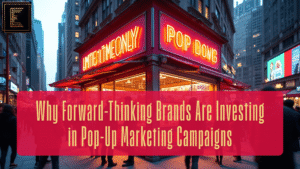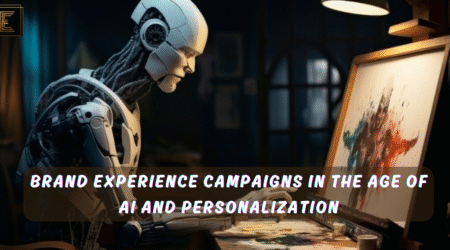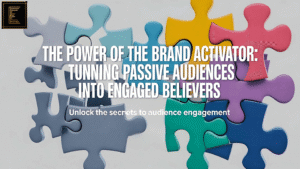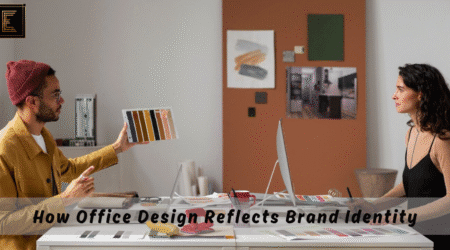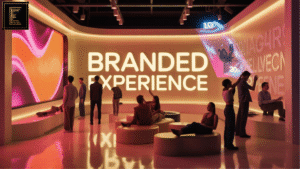Pop-up shops have taken the retail world by storm. These short-term, experiential retail spaces offer brands a unique opportunity to engage customers, test products, and create buzz. However to make a pop-up shop successful, branding plays a crucial role.
Why Pop-Up Shops Are a Game-Changer for Brands
The Power of Pop-Up Retail
Pop-up shops allow brands to:
- Create a sense of urgency – Limited-time availability drives customer interest.
- Test new markets – Brands can explore new locations without long-term commitments.
- Enhance customer engagement – Face-to-face interactions build stronger connections.
- Boost brand awareness – Unique experiences create word-of-mouth marketing.
- Drive online traffic – A well-executed pop-up shop increases digital engagement.
How Branding Impacts Pop-Up Shops
Effective branding helps businesses:
- Stand out in a crowded retail landscape.
- Build emotional connections with customers.
- Reinforce brand identity through visual consistency.
- Drive sales by creating memorable shopping experiences.
Essential Pop-Up Shop Branding Strategies
1. Define Your Brand Story
Your pop-up shop should reflect your brand’s mission, values, and personality. To craft a compelling story:
- Know your audience – Understand their preferences and pain points.
- Align with brand identity – Maintain consistency with your brand’s core values.
- Create an immersive experience – Engage customers through storytelling elements.
2. Design a Visually Striking Space
The aesthetics of your pop-up shop should be eye-catching and cohesive.
- Use bold signage – Ensure your brand name and logo are highly visible.
- Incorporate brand colors – Create visual consistency with your existing branding.
- Utilize creative displays – Showcase products in innovative ways.
- Invest in lighting – Proper lighting enhances product visibility and ambiance.
3. Offer Unique and Interactive Experiences
To leave a lasting impression, engage customers through interactive elements.
- Product demonstrations – Showcase product features live.
- Workshops and DIY stations – Let customers create something unique.
- Augmented Reality (AR) experiences – Allow customers to interact digitally.
- Social media integration – Encourage users to share experiences online.
4. Leverage Social Media & Influencer Marketing
Maximize exposure through digital engagement.
- Create a branded hashtag – Encourage user-generated content.
- Host live events – Use Instagram Live or TikTok to generate buzz.
- Collaborate with influencers – Tap into their followers for greater reach.
- Offer social media giveaways – Incentivize customers to share content.
5. Make It Exclusive & Limited-Edition
People love exclusivity. Create a sense of urgency by:
- Offering limited-time products – Special collections drive demand.
- Providing early access – Reward loyal customers with exclusive invites.
- Using scarcity tactics – Display stock numbers to encourage purchases.
Real-World Success: A Case Study on Effective Pop-Up Branding
Nike’s Sneaker Pop-Up
Nike successfully used pop-up branding to:
- Create hype with limited-edition sneakers.
- Offer interactive experiences like sneaker customization.
- Leverage influencer marketing by inviting sports celebrities.
- Use digital marketing to generate long queues before launch.
Common Mistakes to Avoid in Pop-Up Shop Branding
1. Ignoring Brand Consistency
- Ensure your pop-up aligns with your existing branding.
- Use the same logo, fonts, and colors for brand recognition.
2. Poor Location Choice
- Research high-footfall areas for better visibility.
- Consider your target audience when selecting a spot.
3. Lack of Marketing Efforts
- Promote your pop-up weeks in advance.
- Use email marketing, press releases, and social media campaigns.
4. Ignoring Customer Experience
- Train staff to provide excellent customer service.
- Offer a seamless checkout experience.
- Provide free samples or gifts for engagement.
The Future of Pop-Up Shops: Trends to Watch
1. Digital-First Pop-Ups
- Integration of e-commerce features.
- Use of QR codes for instant purchases.
2. Sustainable Pop-Ups
- Eco-friendly materials and reusable displays.
- Brands emphasizing zero-waste initiatives.
3. Data-Driven Pop-Ups
- Use of AI and analytics to optimize performance.
- Personalized shopping experiences through customer data.
Conclusion: Transforming Temporary Spaces into Lasting Impressions
Pop-up shop branding is an art that combines creativity, strategy, and customer engagement. To maximize impact:
- Tell a compelling brand story.
- Design an immersive and visually appealing space.
- Leverage social media and influencer marketing.
- Offer exclusive and interactive experiences.
- Stay consistent with branding elements.
When done right, pop-up shops can leave a lasting impression and elevate brand recognition beyond the temporary storefront.
FAQs
1. How do I choose the right location for my pop-up shop?
- Research areas with high foot traffic.
- Ensure the space aligns with your brand audience.
- Consider proximity to complementary businesses.
2. What budget should I allocate for a pop-up shop?
- Factor in rent, design, staffing, and marketing costs.
- Start with a smaller-scale test before expanding.
- Consider sponsorships and partnerships to offset costs.
3. How can I make my pop-up shop Instagram-worthy?
- Use aesthetically pleasing decor.
- Provide unique backdrops for photos.
- Encourage hashtags and user-generated content.
4. What’s the best way to measure the success of a pop-up shop?
- Track foot traffic and sales.
- Monitor social media engagement.
- Gather customer feedback through surveys.
5. How long should a pop-up shop last?
- Most pop-ups run for a few days to a few weeks.
- The duration depends on your goals and budget.
- Shorter durations create a stronger sense of urgency.



